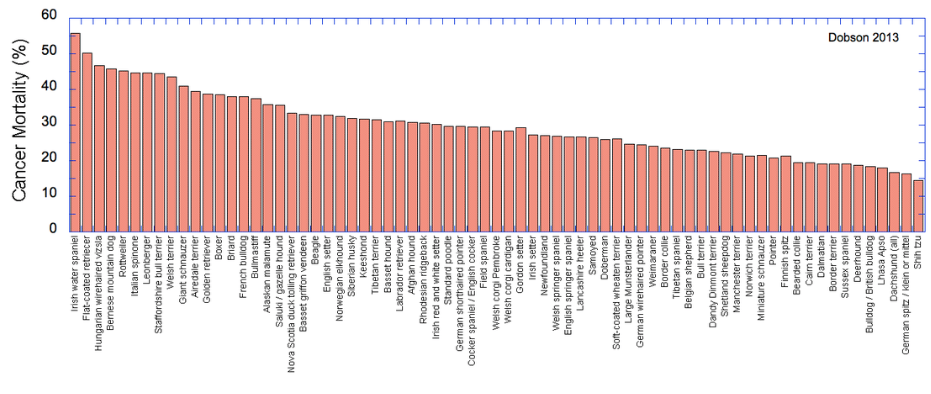(All of the original data from this study, including breeds and other health problems that don't appear here, are available for download here.)
On the ICB website, I've posted some graphs drawn from published data for breed-specific cancer rates in dogs (samples from the UK). I have to say there were a few surprises in there for me. It was my impression that theposter child for cancer was the Bernese Mountain Dog, perhaps followed closely by the Flatcoat and Golden Retrievers. But have a look at this list, in order of percentage of all deaths with a cancer-related cause (there are links to larger versions of the graphs below)
2) Flat-coated Retriever (50%)
Roughly 45% -
- Wirehaired Vizsla
- Bernese Mtn Dog
- Rottweiler
- Italian Spinone
- Leonberger
- Staffordshire Bull terrier
- Welsh Terrier
Roughly 40% -
- Giant Schnauzer
- Airedale
- Golden Retriever
- Boxer
- Briard
- French Bulldog
- Bullmastiff
Roughly 35% -
- Alaskan Malamute
- Saluki
- Toller
- Basset Griffon Vendeen
- Beagle
- English Setter
- Norwegian Elkhound
- Siberian Husky
- Keeshond
- Tibetan Terrier
- Basset Hound
- Labrador retriever
--------->
- Afghan
- Ridgeback
- Irish R&W Setter
- Standard poodle
- German Shorthaired Pointer
- English Cocker
- Field Spaniel
- Welsh Pembroke
- Welsh Cardigan
- Gordon Setter
< You can explore the paper for data on other breeds (pdf). >
Top of the list is the Irish Water Spaniel??? And also unexpectedly high on the list are Rottweilers, Spinone, Staffys, Welsh Terriers, and only farther down the list is the Golden Setter, sharing the rank with (more surprise) Giant Schnauzers, Boxers, and Frenchies (!!!???).
The oft-repeated "cancer number" for Goldens is 60%, far higher than the worst of this list, and although I've never been able to source that number the fact that it is listed in official Golden club documents gives it some credibility (is the US rate so much higher than in the UK, anyone?).
Now, I can already hear somebody saying that what if all these dogs are dying of cancer when they're 14 years old - is that really cause for alarm? Good question. Fortunately the paper also records age at death for these dogs, and these data were very interesting as well. Listed from youngest:
Age less than 7 yrs
1) Bulldog
2) Leonberger
Age 7-8 yrs
3) Bullmastiff
4) Toller
5) Bernese Mountain Dog
Age 8-9
6) Deerhound
7) Rottweiler
8) French Bulldog
9) Italian Spinone
10) Irish Water Spaniel
Age 9-10
11) Newfoundland
12) Flatcoated Retriever
13) Giant Schnauzer
14) German Wirehaired Pointer
15) Bull Terrier
16) Boxer
These are breeds that are dying of cancer at ages (on average) of less than 10 years old. These are not old dogs, although some breeds don't seem to live much longer than this in general. From my personal discussions with people, it's clear that Berner, Golden Retriever, and Flatcoat breeders are definitely aware that cancer is a serious problem in their breeds. But what about these other breeds that are high on the list?
You can compare the causes of death categorized as cancer, urologic, cardiac, and old age by breed here -
http://www.instituteofcaninebiology.org/breed-comparions.html
You can check out my graphs of the cancer data here -
http://www.instituteofcaninebiology.org/cancer.html
...and you can download a copy of the publication the data are from here -
Dobson JM 2013 Breed-predispositions to cancer in pedigree dogs. ISRN Vet Sci 2013: article ID 94125
http://www.hindawi.com/journals/isrn/2013/941275/
If you're curious how long particular breeds live just for comparison, you'll find some data under the DATA tab on the ICB site under "Lifespan".
If you found this to be useful, please consider supporting ICB by becoming a Member.
And join the discussion in our FACEBOOK GROUP - ICB Breeding for the Future


